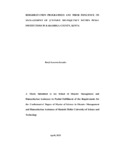REHABILITATION PROGRAMMES AND THEIR INFLUENCE ON MANAGEMENT OF JUVENILE DELINQUENCY WITHIN PENAL INSTITUTIONS IN KAKAMEGA COUNTY, KENYA
Abstract
Juvenile crime has been on the rise globally. Rehabilitating juveniles have proved to be unsuccessful resulting to delinquents committing more crimes repeatedly. The overall objective of the study was to assess the effectiveness of rehabilitation programmes within penal institution and their influence on management of juvenile delinquency in Kakamega County, Kenya. The specific objectives of the study were; to examine the nature of rehabilitation programmes being enforced in juvenile penal institution in Kakamega County, Kenya; to evaluate the effectiveness of rehabilitation programmes in management of juvenile delinquency within penal institutions in Kakamega County and, to explore strategies for enhancing rehabilitation programmes in management of juvenile delinquency in Kakamega County, Kenya. The study was guided by the social disorganization theory which argues various aspects contribute the chances of juveniles engaging in criminal acts. Social learning theory helps the juveniles learn positive role models thus preventing them from antisocial behaviors. The target population was 918 who included juveniles, key informants and respondents through FGDs. Snowball sampling was used to sample relapsed juveniles and convenience sampling for reformed juveniles. Purposive sampling was used to sample key informants and random sampling was used for sampling committed juveniles. A total of 335 respondents were sampled. The study used primary and secondary data. Primary data was collected by use of questionnaires, interviews, FGDs and observation checklists and secondary data was collected through journals, manuals and written records. Qualitative data was collected through interviews, FGDs and observation checklists which were coded and analyzed thematically. Quantitative data was analyzed by descriptive statistics namely, frequencies and percentages using statistical package for social science and presented in form of figures and tables. Additionally, Spearman’s rank order correlation was used for objective one and two while chi-square was used for objective three. Qualitative data analysis was done through coding, voices and narratives. With regard to nature and extent of rehabilitation programmes being enforced in penal institutions, the study found that majority of the juveniles who committed crimes were between the ages of 15-18 years. Males were the majority at (83.9%) while females were (15.1%). Stealing was the most committed crime at (53.3%). Most of the juveniles in penal institutions were brought up by single mothers at (38.7%). Penal institutions were guided by policies and guidelines and also governed by rules and regulations. Majority of the juvenile (43.7%) revealed the court process took one year and legal representation for the juveniles was at (67.8%). With regard to objective two, the programmes offered were vocational training, guiding and counseling and formal education. Rehabilitation process was not successful at (94.7%). With regard to objective three, it was found that the strategies on follow up after release programs (40%), strategies on program match (34%) and strategies on trauma- informed approaches (26%) were effective in managing juvenile delinquency. The study recommends that the government should provide more learning facilities especially in vocational training and formal education programmes for effective delivery of service to the juveniles, the government should introduce assessment tools in order to match the requirements for treatment and penal institutions, introduced after care services for effective reintegration of juveniles.

